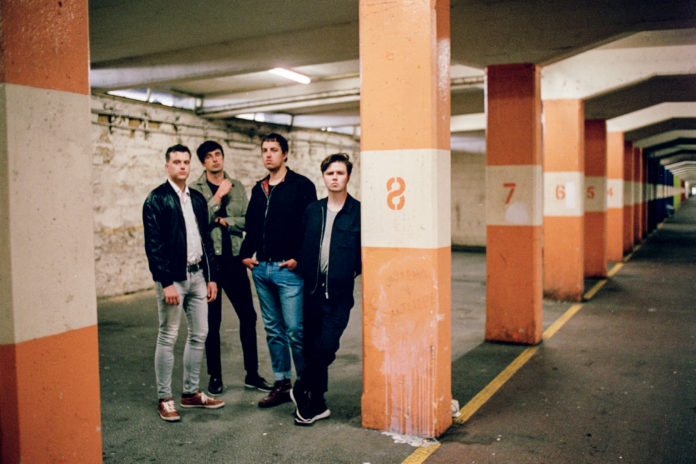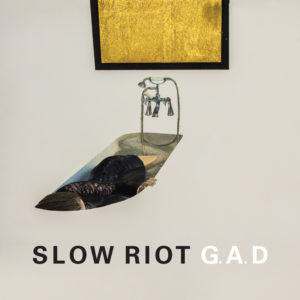The Limerick band left the stage in 2018 with their debut long player poised for release, G.A.D will finally be released on November 15, 2019.
LIMERICK band Slow Riot were set to become the next big thing in 2018 for many observers here in Ireland and in the UK. including BBC 6Music, Today FM, Q Magazine, The Line Of Best Fit, Hot Press and The Irish Times.
The trio had made their own post-punk sound with strong melodies and layers of driving guitars carved from their Interpol and Joy Division influences.
Signed to London label Straight Lines Are Fine, Slow Riot recorded their debut EP ‘Cathedral’ with Kevin Vanbergen (The Pixies, The Maccabees, Biffy Clyro) in Manic Street Preachers’ Faster Studio in Cardiff. Well received singles ‘Pink December’ and ‘Voyeur/Burn in the City’ followed. In the meantime the band became a four piece with the addition of second guitarist Liam O’Connor (formerly of Fonda) expanding on their live sound possibilities.
UK tours, strong shows at Electric Picnic and Other Voices Festival and appearances on Other Voices’ TV show and a live set on Paul McLoone’s radio show on Today FM all cemented Slow Riot’s growing reputation as serious contenders.
With the debut album completed in early 2018 and a slew of gigs to play, the band suddenly announced that it was all over on August 1: “Unfortunately due to circumstances beyond our control we have to cancel a run of upcoming gigs. Sincere apologies to all the promoters involved.”
The harsh realities and demands of being in a recording and touring new band in 2018/19 had caught up with Slow Riot. The split was the unfortunate result. While fans knew that an album was recorded, there was no further comment from the quartet … that is until October 2019 when record company Straight Lines Are Fine announced that the long awaited album ’G.A.D’ will be released on Friday November 15. The album will be preceded by the band’s final single ‘A Lighthouse’ this November 1.
While the band has not yet responded positively to interview requests on the album release, they have asked long-time fan Professor Eoin Devereux, Department of Sociology, University of Limerick, to write an introduction to ‘G.A.D.’ to contextualise their work. See the full text of his introduction here.
‘‘
WHEN VIOLENCE IS SINGING… Slow Riot’s G.A.D
by Eoin Devereux
It does not really matter that this will be Slow Riot’s only album. What matters most is that even with its belated release, ‘G.A.D.’ can justifiably take its place as a truly powerful collection of songs etched forever in the Post-Punk soundscape. Brimful of creative and personal tensions, ‘G.A.D.’ reminds us that sometimes the best art is created once, and once only – and it often comes from a very dark place.
We shouldn’t at all be surprised about the sheer brilliance of this farewell/debut album. After all, in their four short years, Slow Riot quietly, but assuredly, raised their heads above the parapet and presented the listening world with razor sharp and compelling songs like ‘Demons’, ‘Trophy Wife’ and ‘Voyeur.’ Blissful melodies framed by angular poetic lyrics; songs mixing darkness, shade and light, songs full of despair and hope, songs that saved our lives.
Slow Riot’s sound and overall aesthetic – best evidenced in their artwork and videography – drew comparisons with long established international luminaries such as Joy Division, Wire, Interpol and The Cure. And while such comparisons served to locate the band in a particular musical context, at best, this only told half the story because, in their own right, Slow Riot were busy creating something new and distinct whose endgame resulted in the sonic masterpiece that is ‘G.A.D.’
Beginning life as a three-piece (Niall Clancy, bass, vocals; Aaron Duff guitars and Paul Cosgrave, drums), Slow Riot formed in the Post-Industrial city of Limerick in the Southwest of Ireland in 2015. Opting for a name that is in itself contradictory, Slow Riot’s sound carried aural resonances of a crumbling stigmatized Third City, not quite sure of itself, caught between the future and past. In this regard, it is noteworthy that Slow Riot’s first release – the urgent and frenetic ‘City of Culture’ was an acerbic reflection on those who thought that the city’s endemic poverty, alienation and exclusion could somehow be papered over through top-down cultural initiatives.
With the circulation of Slow Riot’s early demos and single releases, music fans and critics alike began to sit up and pay attention. A solid output of very strong songs, intelligent videography, now legendary live shows and radio sessions resulted not only in positive reviews in the music press but also in record label interest in the UK.
Three became four, with the addition of Liam O’Connor from the band Fonda on guitar and an emboldened Slow Riot seemed poised for global stardom. I, for one, felt certain that the band would soon be following in the footsteps of The Cranberries – another Limerick band who defied all the odds by making their considerable mark overseas.
For all sorts of reasons, it was not meant to be. But before the band’s decision to call it day, they created their final calling card. As an album, ‘G.A.D.’ throws a searchlight on Slow Riot’s musical dexterity and lyrical prowess. Assuming that title refers to the clinical condition commonly known as Generalized Anxiety Disorder, the imagined characters in the album’s songs experience hyper-anxiety, implicit and explicit violence, troubled and obsessive human relationships in a dystopian urban setting.
These songs are important because they tell about the realities and dangers of being young and male in the early Twenty First Century.
It is particularly telling that Slow Riot elected to use a vivid painting by Irish artist Darragh Dempsey as G.A.D’s cover art. One reading of the image is that it refers to a self-inflicted death, of a life extinguished. Dempsey’s original oil on canvass entitled ‘Táthar ag súil le saol nua’ (which translates from Gaelic as ‘a new life is expected’), might signify a new life in the next world. However, the image could also be interpreted as signifying a ritual cleansing before a new beginning. And so, while the band may be dead, the very welcome release of ‘G.A.D’ signals a new beginning for all the members of Slow Riot.
Professor Eoin Devereux is co-director of the Popular Music and Popular Culture Research Cluster at the University of Limerick, Ireland.






